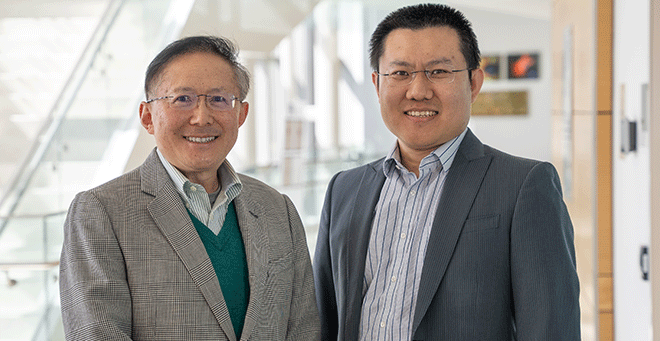Gene therapy researchers at UMass Chan Medical School have shown the first evidence that a suppressor transfer RNA (tRNA) therapy can restore protein production up to six months after treatment in a mouse model of the rare genetic disease mucopolysaccharidosis type I, according to a new paper published in Nature.

Guangping Gao, PhD, Dan Wang, PhD, and colleagues report on AAV-delivered “nonsense suppressor tRNAs operating on premature termination codons,” or AAV-NoSTOP for short. The research supports the development of a new toolbox of suppressor tRNA therapies that can potentially restore native gene function in a host of tissues, including heart, muscle, brain and liver, thereby alleviating genetic diseases caused by premature stop codon mutations.
Gene replacement and transgene therapies focus on repairing or reconstructing defective genetic material to produce a therapeutic effect. Current gene therapy approaches face challenges such as toxicity, unwanted off-target effects and harmful immune reactions. Meanwhile, gene editing machinery such as CRISPR-based systems can be challenging to deliver, due to their size and the limited cargo space of most delivery mechanisms. Because tRNA therapies utilize the cell’s native cellular protein-making machinery and are relatively small, they have the potential advantage of restoring endogenous gene regulation with fewer of these challenges. Technological limitations, however, have hindered scientists from doing formal studies addressing the safety, efficiency and efficacy of a tRNA gene therapy in a disease animal model.
“Ours is the first formal study to provide evidence in an animal model of a human disease that tRNA-based therapies can safely restore gene expression,” said Dr. Wang, assistant professor of RNA therapeutics. “We show that it’s possible to deliver a tRNA platform in vivo with long-term safety and efficacy in a diseased animal. By achieving long-term gene expression in an animal, suppressor tRNA opens up a whole new opportunity to build gene therapies for a broad range of genetic disorders.”
Transfer RNAs play a critical role in how proteins are made inside a cell. They are responsible for physically bringing together the various amino acids that, when combined, form functional proteins. Similar to messenger RNA (mRNA), which carries the instructions for assembling amino acids in the right order to form proteins, each tRNA molecule physically connects amino acids to the correct mRNA sequence. These tRNAs bind to amino acids and carry them to the protein-making machinery in the cell called the ribosome. At the tip of each tRNA is an anticodon, a three-nucleotide sequence. This anticodon corresponds to a complementary sequence along the mRNA strand. As the ribosome “reads” the mRNA, the tRNA is responsible for moving, and then transferring, its amino acid to the correct position along the mRNA sequence.
Inside each mRNA instruction booklet are additional directions—called stop codons—that tell the ribosome machinery when a protein is complete and when to stop adding amino acids. In some cases, however, a single nucleotide mutation inside a gene can cause the ribosome to prematurely stop building proteins. These premature stop codons produce incomplete proteins that can become toxic to the cell or result in proteins that are no longer able to carry out their required function—in some cases, both toxicity and loss of function ensues.
“About 11 percent of all genetic diseases are caused by a single nucleotide mutation that results in a premature stop codon,” explained co-author Dr. Gao, the Penelope Booth Rockwell Professor in Biomedical Research, professor of microbiology & physiological systems, director of the Horae Gene Therapy Center and co-director of the Li Weibo Institute for Rare Diseases Research. “It may be possible to design a therapeutic platform that uses suppressor tRNA therapy to treat other diseases that form because of premature stop codons. This would include certain types of cystic fibrosis and muscular dystrophy.”
Wang and Gao developed a suppressor tRNA that allows the ribosome machinery to skip over these premature stop codons, causing the protein-making apparatus to continue building a complete and functional protein. Deploying their tRNA therapy, delivered by a recombinant adeno-associated virus (rAAV) to mice with a mutation in the gene called IDUA, the researchers showed it is possible to restore functional protein levels and it did not observe any side effects.
Mutations to the IDUA gene cause the lysosome storage disorder mucopolysaccharidosis type I. The IDUA gene provides instructions for producing an enzyme called alpha-L-iduronidase, which is essential for breaking down large sugar molecules called glycosaminoglycans (GAGs). The lack of alpha-L-iduronidase enzyme activity leads to the accumulation of heparan sulfate and dermatan sulfate within the lysosomes. Researchers believe that the accumulated GAGs may also interfere with the functions of other proteins inside the lysosomes and disrupt the movement of molecules inside the cell.
Gao and Wang chose to test their AAV-NoSTOP on mucopolysaccharidosis type I because the biochemical effects of the disease are present throughout the whole body, allowing for the investigation of multiple tissue types.
Though tRNA technologies have been around for more than 40 years, translating the technology to therapies has been slowed by an inability to assess the biochemical impacts of modifying tRNA sequences. Wang and Gao were able to utilize newly developed technologies in ribosome profiling and tRNA sequencing to biochemically interrogate their results and assess potential off-target effects.
The research findings support the idea that a suppressor tRNA can restore normal protein production, said Wang. Such a platform would eliminate the need to deliver a full-length gene that may exceed the packaging limit of AAV vectors and avoid harmful immune responses caused by gene editing technologies such as CRISPR-associated proteins.
“When combined with the AAV-based gene delivery technology being developed for different tissues, an AAV-NoSTOP platform would be a potentially valuable clinical addition to developing gene-based therapeutics,” said Gao.
Related UMass Chan news stories:
Guangping Gao and Dan Wang partner with ASC Therapeutics to develop novel gene therapy for maple syrup urine disease
Flotte lab to develop gene therapy models for genetic lung disease
UMMS establishes gene therapy collaborative research agreement with Pfizer
New genome-editing strategy developed at UMMS may lead to therapeutics